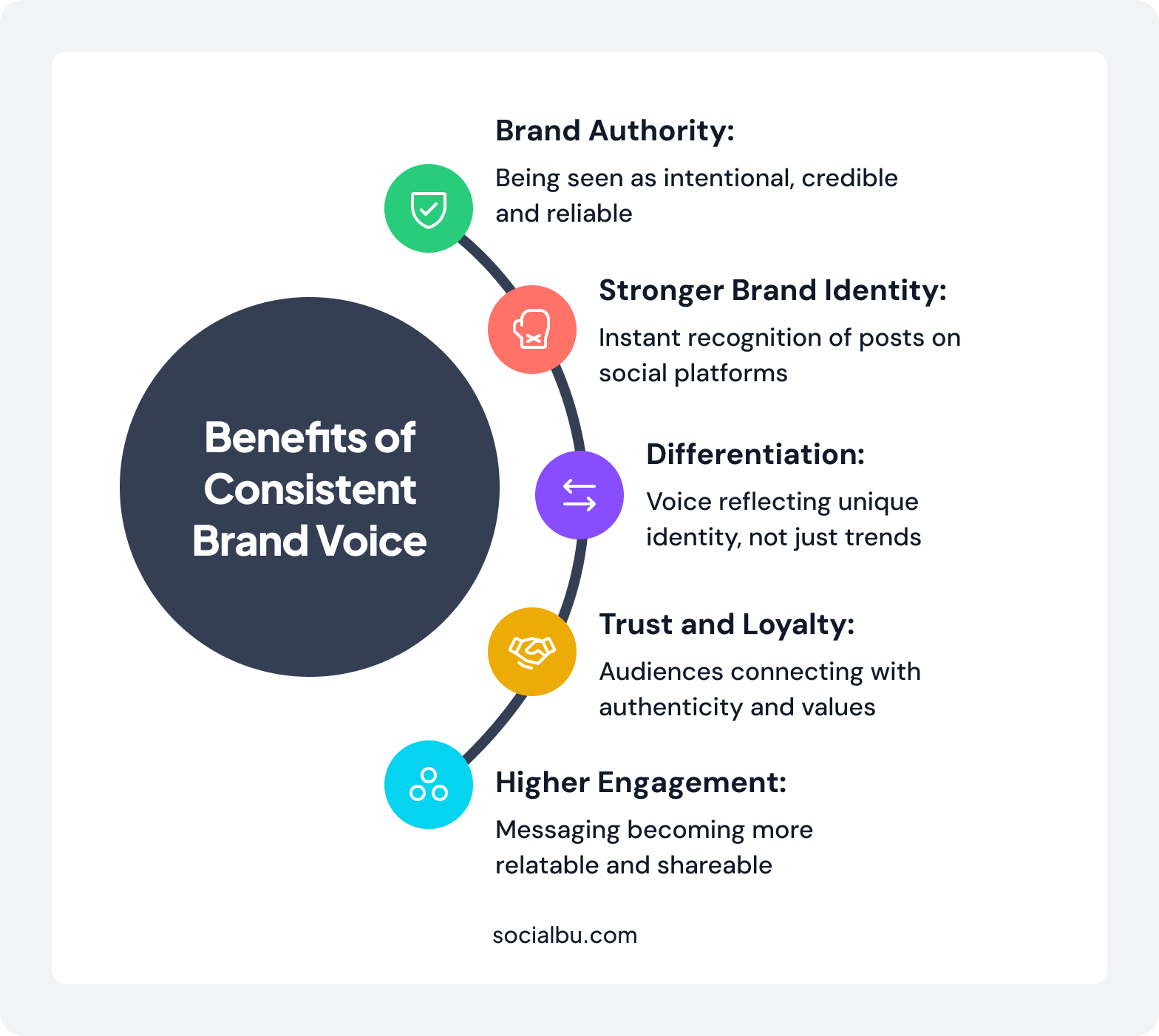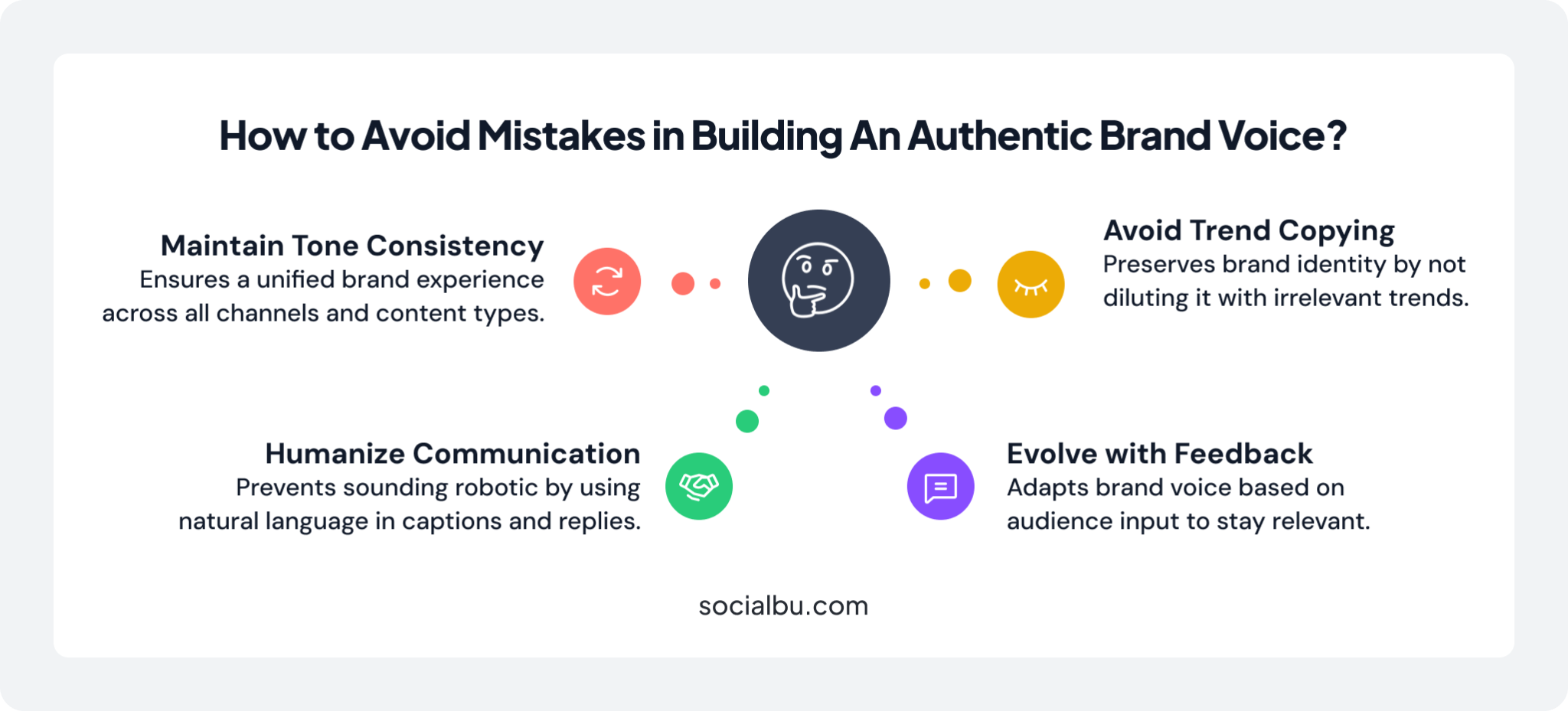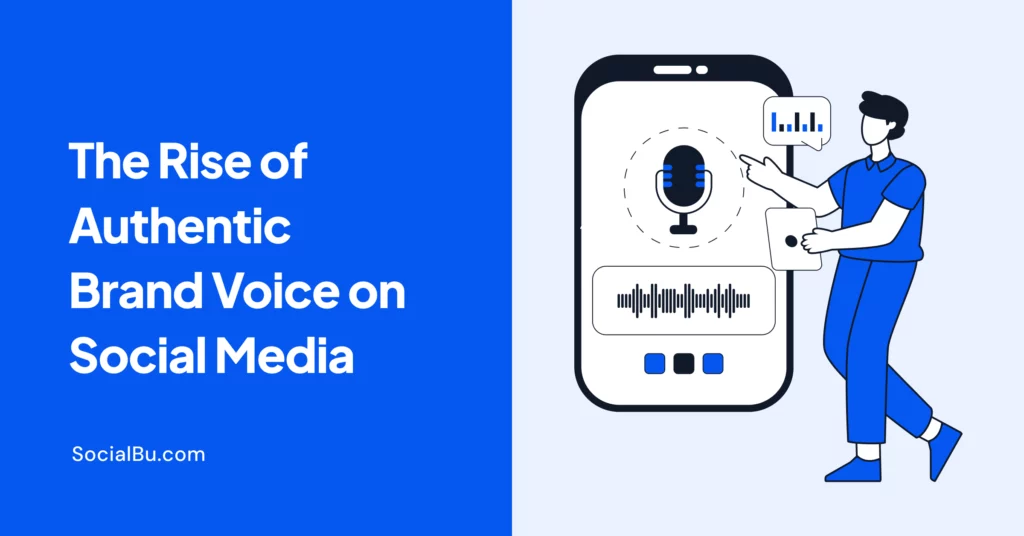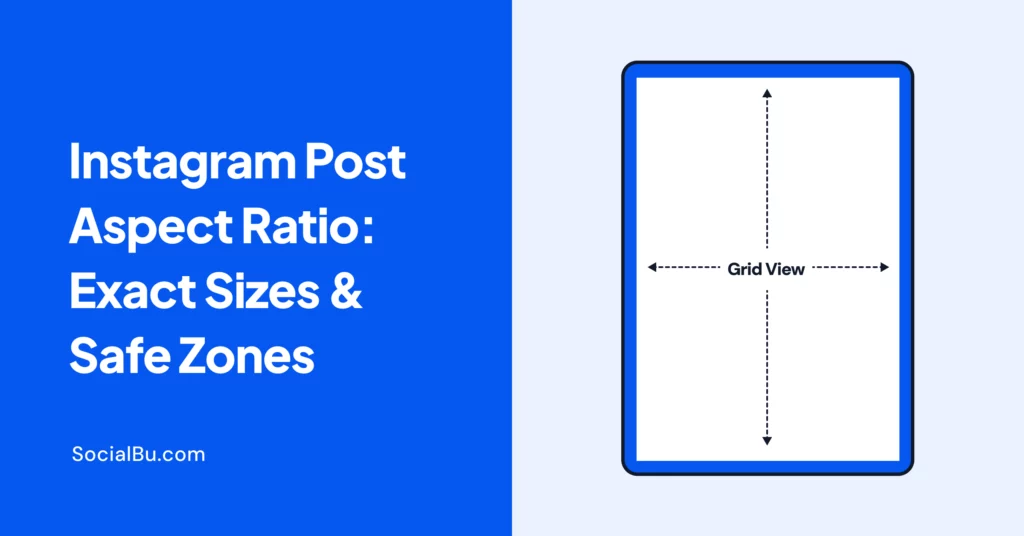With thousands of businesses already rocking online, building your brand image can feel impossible. But here’s the truth: you’re not too late and you’re not missing out on anything. The key to it is to develop and maintain an authentic brand voice on social media.
Your brand voice is what helps your audience connect with you. It’s what builds loyalty, trust, and a real relationship with your followers. It’s not just about what you say but how you say it.
In this blog, you’ll learn:
- What is a brand voice, and why does it matter more than ever
- How to build one that fits your brand identity
- And how to keep it consistent across platforms, even in the age of AI
Let’s explore how an authentic brand voice can set your brand apart.
What is a Brand Voice On Social Media?
A brand voice is the distinct personality, unique communication style, and language your brand uses or expresses across all social platforms. It’s what gives life to your captions, comments, replies, and visuals.
It’s your tone of voice/messaging that builds your brand’s image or recognition and directly connects with your target audience.
And in a space where everyone’s constantly posting, it’s what helps you stand out and be remembered.
As Jeff Bezos famously put it:
This perception is primarily shaped by how you sound online, aka your brand voice.
PS: People recognize you via your tone, messaging, brand style, how you connect with them, or color palette, so make it yours and cash this opportunity.
How does Brand Voice Differ from Brand Tone on Social Media?
Know the difference between brand voice and brand tone on social media to avoid confusion in your messaging.
Brand Voice | Brand Tone |
Your brand’s personality | The emotional delivery of that personality |
Remains always consistent | Can shift based on context |
Example: Helpful, witty | Example: Playful in product launch, calm during a service outage |
Think of the brand voice as who you are, and brand tone as how you express yourself in a given moment.
For example, if your brand voice is friendly and knowledgeable:
Your tone might be upbeat during a feature announcement. And empathetic when addressing a user complaint.
But in both cases, the underlying brand personality remains the same.
Why Authentic Brand Voice Matters More Than Ever
We all know social media is crowded and constantly evolving. If you’re a small or growing brand trying to get noticed, it’s easy to feel like you’re shouting into the void.
But here’s the truth: you don’t need to go viral overnight; you just need to be consistent and authentic. Because, as per a study by Stackla, when choosing a brand to support online, 88% of consumers prefer authenticity over anything else.
Many brands try to be everything to everyone, and that’s where they go wrong. One day, they’re overly formal, the next day they’re trying to be funny with memes.
It results in confusion.
A confused audience doesn’t engage, remember, or trust you. They want brands that have a clear and authentic brand voice and that speak with them via brand storytelling on social media, not at them. That is why humanizing your brand online is essential.
Build an emotional connection with your audience through your brand voice, tone, content, and product. Focus on brand storytelling on social media to build loyalty and trust with your customers.
In a Salesforce report, 62% of consumers reported feeling emotionally connected with the brands they purchase from.
So, a strong and authentic brand voice on social media is what makes people stop scrolling.
Here’s how a clear, stable brand voice helps you cut through the noise:

Now, let’s look at the practical step-by-step process of how you, as a brand or business owner or service provider, can build authenticity in digital marketing.
How Brands Can Build an Authentic Brand Voice on Social Media
“People don’t buy what you do, they buy why you do it.”
– Simon Sinek
This quote perfectly captures why building an authentic brand voice on social media matters.
In a world where your audience is constantly scrolling past thousands of posts, it’s not your features or services that make them stop: it’s your why and what.
- Why did you start all of this?
What is your brand’s:
- Values
- Voice
- Personality
Here’s precisely how to craft a personality-driven marketing strategy that reflects your brand identity on social platforms, builds trust, and deepens your audience connection on social media.
1. Define Your Brand’s Core Personality and Values
Start with the foundation:
- Who are you, and what do you stand for?
- What are your core values and mission?
- Why did you start your brand?
- What are your products and services?
- What problems do you solve?
- What makes your approach unique?
Use the Brand Personality Framework by Jennifer Aaker, which outlines five key brand personality dimensions:
- Sincerity
- Excitement
- Competence
- Sophistication
- Ruggedness
Ask yourself:
- What personality traits define your brand?
- How do you want your audience to feel about you: inspired, empowered, understood, entertained?
- What tone fits your brand best: friendly, witty, authoritative, empathetic?
For example, at SocialBu, one of our core values is helping users automate their social media workflow with AI. So, our voice is approachable, helpful, and slightly playful because we make something complex feel simple and fun.
Pro tip: Your tone should be consistent across all content: captions, Reels, blogs, DMs, while still being tailored to the platform. This is the basis of consistent brand messaging and compelling brand storytelling on social media.
2. Understand Your Audience and How They Speak Online
To connect emotionally with your audience, you first need to listen.
Research your audience’s:
- Demographics (age, location, profession)
- Pain points (what challenges are they facing that you solve?)
- Online behavior (which platforms they’re on, what content they engage with)
- Language (formal/informal, slang, emojis, acronyms) and grammar style.
Use tools like:
- Social media analytics
- Instagram Polls
- Comment sections
- Q/As
- Surveys
- Buyer persona templates
- Conversations on platforms like Reddit, Twitter, or Quora
According to stats, 77% of consumers are more likely to purchase from brands that share their values. That’s why aligning your brand communication style with your audience’s worldview is more powerful than just pitching features.
When you speak their language and show them you understand their world, you create genuine authenticity in digital marketing and build an emotional connection with your audience.
3. Audit Your Current Voice and Tone Across Channels
As Lisa Horn (The Publicity Girl) puts it:
That means every caption, reply, Reel, thread, or tweet is an impression of who you are, highlighting the importance of social media presence for your brand. Your audience is quietly forming opinions about who you are and whether they want to follow along.
So, conduct a brand voice audit by asking:
- Is our tone consistent across platforms?
- Does our current content reflect our values and voice traits?
- Are we sounding robotic or human?
- Are we connecting or just broadcasting?
Look at:
- Captions
- Customer replies
- Visual tone (colors, fonts)
- Stories and Reels voiceovers
- Blog posts or newsletters
This step is about identifying areas where your brand voice feels off or disconnected and fixing it to make your brand more humanized online.
4. Create a Brand Voice Style Guide
Now that you know your personality, audience, and current gaps, document it all.
Your Brand Voice Guide should include:
- Brand mission and core values
- 4–5 key voice traits with tone examples (e.g., helpful, witty, empowering)
- Preferred language (conversational, technical, vocab, and sentence structure, emoji use)
- Preferred tone: formal, casual, informative, serious, or empathetic)
- Branded hashtags and visual guidelines (color palette and scheme, fonts, imagery tone)
- Voice use-cases across formats: blogs, Reels, tweets, replies, stories, etc
- Audience personas and how messaging shifts slightly per persona
- Document all the Do’s and Don’ts for brand tone on social media (e.g., “Do use humor, don’t be sarcastic”). This will help you and your team stay on track and build trust through a consistent social media voice.
Tip: This guide helps keep your brand storytelling on social media consistent, whether you’re a team of one or 20. So, prepare a formal document or a Notion template.
Are you managing multiple social profiles? Then try SocialBu. It lets you create, schedule, and repurpose content while keeping your brand tone unified across platforms.
5. Adapt Voice by Format Without Losing Consistency
What works on Instagram might fall flat on LinkedIn. But that doesn’t mean your voice needs to change completely.
Instead:
- Use platform-native formats (Reels, Stories, Carousels, Tweets, LinkedIn Articles)
- Tailor tone based on platform context: Engaging and playful on Instagram, insightful on LinkedIn, witty on Twitter
- Repurpose the same core message in ways that suit each platform’s audience and language.
This is where brand tone on social media evolves without losing its soul. Stay true to your core, but switch the delivery.
For example, a how-to blog can become:
- A carousel on Instagram
- A one-minute tutorial on TikTok
- A thought-leadership post on LinkedIn
Use SocialBu to schedule and preview posts on each platform to ensure brand voice alignment everywhere.
6. Evolve Your Brand Voice Over Time with Feedback
The most authentic brand voices evolve, not by guessing, but by listening.
Here’s how to do it:
- Monitor comments, DMs, shares: what resonates most?
- Check social media analytics regularly.
- Run polls to ask how your audience perceives your tone
- Test different tones (e.g., fun vs. motivational) in captions or videos
- Track performance and refine
Use SocialBu’s analytics feature to track which tone or content format drives the most engagement. Let data guide your voice.
Bottom line: Your social media voice evolution doesn’t mean inconsistency. It means being flexible while staying true to your values. Be human, be real, and always be listening.
Test, learn, tweak, and implement again. And let SocialBu simplify the entire workflow of staying consistent across every social media channel, post, comment, or video.
How to Maintain an Authentic Brand Voice in this AI Era
With the rise of AI-generated content and automation tools, it’s easier than ever to churn out social media posts at scale.
But here’s the catch: your audience can spot a robotic tone from a mile away.
While AI can boost productivity, over-reliance can lead to losing your brand’s personality and hurting your emotional connection with your audience. That’s why maintaining a human-first, personality-driven marketing approach is more crucial than ever.
Here’s how you can keep your brand voice real and relatable in the age of AI:
- Blend human tone with automation: Use AI tools like SocialBu to streamline posting, but always add your personal touch to captions and replies, and align with your brand storytelling on social media. Customize templates with a human-like tone to avoid sounding robotic.
- Be transparent: Share your brand values, mission, and behind-the-scenes moments to build trust.
- Keep your voice consistent: Make sure your tone aligns across all platforms and content formats.
- Use personality-driven marketing: Let your brand’s personality shine through humor, emotion, or storytelling.
- Update your brand voice guide: Review and refine it regularly based on what’s working (using real engagement data).
And here are some mistakes you must avoid when you aim to build trust through social media voice and authenticity in this AI era:

Each of these mistakes creates disconnections and weakens your brand communication style. Instead, focus on staying consistent, thoughtful, and relevant.
How to Ensure Voice Consistency Across Platforms and Team Members
One of the most common mistakes brands make is voice fragmentation, when your messaging feels different on each platform or when multiple team members create content without clear direction. This weakens your brand identity on social platforms and confuses your audience.
To avoid this, build a brand voice cheat sheet tailored for each platform’s content style and audience expectations, while staying true to your core tone and values.
Here’s a quick platform-by-platform breakdown:
- Facebook: Friendly, informative, slightly casual. Focus on community and conversation.
- Instagram: Visual, concise, engaging. Use relatable captions that reflect your brand voice and tone.
- TikTok: Trendy, fast-paced, humorous, or authentic. Show personality in short-form videos.
- LinkedIn: Professional, insightful, value-driven. Thought leadership with a human touch.
- X (Twitter): Witty, direct, real-time. Maintain tone while adapting to brevity and trends.
- Pinterest: Inspirational and instructive. Reflect your brand’s tone in pins and descriptions.
- Google My Business: Clear, helpful, service-oriented. Maintain consistency in updates and responses.
Now, align your brand tone on social media to each platform’s nature, but keep your core values and voice the same. This ensures you deliver consistent brand messaging no matter who posts or where it’s posted.
Pro Tip: Want to manage all your platforms and maintain a consistent brand voice without the chaos of shuffling across each platform manually?
Try SocialBu, your all-in-one social media dashboard to schedule, monitor, and manage content across Facebook, Instagram, LinkedIn, TikTok, and more.
What are Some Examples of Strong Brand Voice on Social Media?
Here are some brand examples that have a strong, honest, and authentic brand voice on social media, and you can learn from or take inspiration from.
Each one stays true to its brand identity while adapting content for different platforms.
1.SocialBu
SocialBu’s brand voice is clear, approachable, and solution-driven, and a little playful too on social media. Its aim is simple: social media doesn’t have to be overwhelming and chaotic when you have the right tool by your side.
The messaging and tone on its Instagram page are friendly, helpful, conversational, and solution-focused, aligned with the target audience. It reflects the product’s core purpose: to simplify social media management and help users save time and stay organized.
From helpful carousels to relatable Reels and practical social media tips, SocialBu communicates with simplicity, uses everyday language, and relatable humor/memes. It showcases how its features solve real problems, from scheduling posts to replying to comments, or juggling multiple platforms.
And on its blog, the brand voice and messaging are also consistent: helpful, with a focus on automation, ease, productivity, and social media updates.
2. Calm
If there’s one word to define Calm’s brand voice across social media, it’s “Calm.” Everything from their captions and visuals to music and tone of messaging is consistent and radiates softness, slowness, intention, and empathy.
Furthermore, they speak like a gentle, trusted friend or therapist, nudging you to breathe, unplug, and embrace inner peace. The message is clear: slow down, relax, prioritize your mental well-being, and live creatively and mindfully.
What Makes Their Brand Voice Stand Out
- Message, tone, language, or daily reminders that soothe: “Take a deep breath” or “Drink more water.”
- Peaceful visuals and ambient music to match or elevate the mood.
- Every post aligns with their core values, mindfulness, rest, and emotional healing.
Embed video
It’s a brilliant example of a brand where the brand voice consistently matches the brand name, mission, and user emotions. The overall focus is on the user to make them feel calm.
3. Slack
Slack has a unique and authentic brand voice in the B2B industry. Its communication style is clear, concise, helpful, and human, just like the product experience itself.
The platform’s mission is to simplify workflows and improve working life by keeping it productive with AI agents and pleasant. Features like channels for organized communication, integrations with your favorite tools, and powerful search help teams stay productive and connected.
Moreover, Slack also follows well-defined brand guidelines for tone, use of emojis, and language. Even in support messages or UI copy, the voice stays approachable yet professional.
On social media, Slack consistently showcases its product value, the importance of team collaboration, and a modern, empathetic take on work culture.
Wrap Up
So, by now, you have got everything on brand voice on social media and how to develop your brand’s authentic voice, and some examples to take inspiration from.
What’s the next step?
If your goal is to keep your brand humanized and to connect, engage, and grow over time, your brand voice on social media has to be clear, consistent, and real.
Remember:
- Define your brand voice based on your values, personality, and audience.
- Apply it consistently across platforms.
- Evolve it based on feedback, engagement data, and shifting brand engagement trends.
And the best part: you don’t need to do it all manually or juggle tools. SocialBu helps you stay consistent, human, and on-brand across every platform, at scale.
Ready to sound like YOU everywhere online? Try SocialBu today and simplify your social media game.
FAQs
What are the main elements of brand voice?
Tone, language style, and personality are the key elements of a brand voice. Together, they shape how your brand sounds and feels to your audience on social media.
What does branding mean in social media?
Branding on social media refers to how a brand presents itself through visuals, content, and brand voice. It’s about creating a recognizable and authentic presence that aligns with your values.
How important is brand voice?
Your brand voice is crucial for authenticity in digital marketing. It helps establish emotional connections, drives engagement, and sets your brand apart in a crowded online space.
How to develop a brand voice?
Start by defining your brand’s values, audience, and personality. Then create a voice guide to ensure consistent brand messaging across all content.
What is brand voice on social media?
Brand voice on social media is the unique tone and style your brand uses to communicate online. It reflects your brand identity on social platforms and helps you connect with your audience meaningfully.
How do I define my brand voice for social platforms?
Analyze your brand’s core values, your ideal audience, and what tone fits your message: friendly, expert, witty, etc. Test and refine based on engagement insights to stay authentic and relevant.
Why does brand voice matter on social media?
It ensures your audience knows who you are and what you stand for. A straightforward, consistent brand messaging approach builds trust and brand loyalty over time.
How do you develop an authentic social media brand voice?
Use your core values and audience feedback to shape your tone. Avoid sounding robotic, aim for personality-driven marketing with a human, relatable tone.
How can brand voice improve customer engagement?
When your voice resonates emotionally, people are more likely to comment, share, and respond. It strengthens your brand identity on social platforms and encourages loyalty.
What steps can small businesses take to establish their brand voice online?
Create a simple brand voice guide, observe what resonates with your audience, and start posting consistently. Tools like SocialBu can help maintain this voice easily across channels.
How can brands maintain consistency in their social media voice across platforms?
Develop a centralized voice guide and adapt your tone per platform while keeping your fundamental message intact. Use tools that support consistent brand messaging and scheduled publishing.
Can brand voice help build trust and credibility on social media?
Yes, when your voice is genuine and consistent, it reflects authenticity in digital marketing, making people more likely to trust and engage with your brand.







